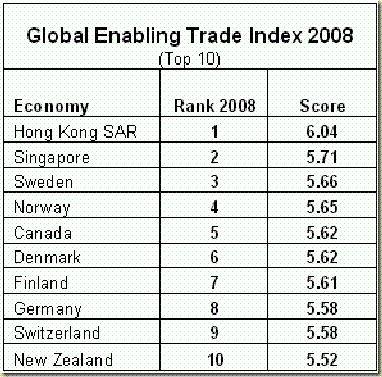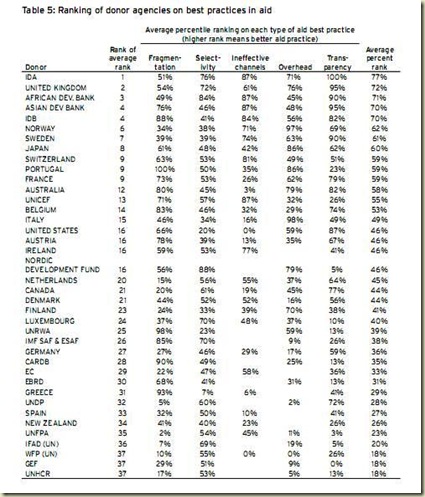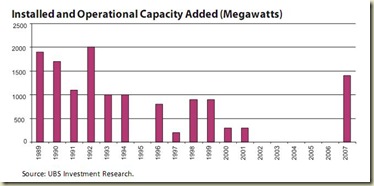The World Economic Forum (WEF) has published a report titled The Global Enabling Trade Report 2008, which ranks countries by looking at four issues/indexes: market access, border administration, transport and communications infrastructure, and the business environment.
The first subindex measures the extent to which the policy and cultural framework of the country welcomes foreign goods into the country. Once goods have been allowed in to the country, the second subindex assesses the extent to which the administration at the border facilitates their entry. Once goods have made it over the border, the third subindex takes into account whether the country has the transport and communications infrastructure necessary to facilitate the movement of the goods from the border to destination.
These "pillars of enabling trade" are further divided into ten subindexes: tariffs and non-tariff barriers, proclivity to trade, efficiency of customs administration, efficiency of import-export procedures, transparency of border administration, availability and quality of transport infrastructure, availability and quality of transport services, availability and use of ICTs, regulatory environment, and physical security.
The index basically measures the factors, policies, and services facilitating the free flow of goods over borders and to destination. The top ten countries based on the index are:

The results bear witness to Hong Kong and Singapore’s openness to international trade and investment as part of their successful economic development strategy. Both countries have put into place customs administrations that are highly efficient in getting goods over borders. They are also endowed with well developed transport and telecommunications infrastructures ensuring rapid transit to final destination. These attributes are further supported by business environments that are conducive to the logistics and transport industry.
The report describes China's trade position as:
China occupies the 48th position.This fairly low position for one of the world’s most successful exporters highlights a number of underlying weaknesses in China’s economy and its trading regime.Above all, China is a fairly closed country. Although its economic success relies heavily on exports, imports are still severely inhibited by tariff and non-tariff barriers, despite the country’s accession to the WTO.The country ranks 108th out of 118 economies on tariff barriers, which amount to almost 15 percent.The country’s border administration is fairly efficient; importing products is not costly, although it can be quite time-consuming. A particular concern when exporting and importing is the lack of transparency of border administration, which can be particularly heavy for foreign businesses. Because of large export volumes, the country is well connected to international markets, yet its transport infrastructure is not on a par with the world’s best. In particular, airport density and the quality of air transport infrastructure are fairly low.The quality and availability of transport services, however, are among the best in the world, ranked 17th overall. Improvements to the regulatory and security environment would further enable trade. In particular, greater encouragement of FDI and more openness to foreign air transport service providers would help.
About India:
Further down the rankings we find India, at 71st place. India’s weak position reflects a mixed performance on the four pillars of the ETI.While it boasts fairly good border administration and an acceptable business environment, market access continues to be severely restricted. Indeed, India ranks 105th on the relevant component with, unlike most other countries, tariff barriers representing a more serious impediment than nontariff barriers. Only a small share of goods is imported duty-free. India’s border administration meets many needs of importers and exporters. Ranked 55th on this indicator, a vast number of customs-related services is available in India and clearance entails low pecuniary costs, although it is time-consuming. Border administration continues to be affected by corrupt practices, however, hampering an efficient transport of goods across borders.Trade-related infrastructure and the relevant services are equally fairly well developed in India, ranking 52nd in the overall sample. However, although the country is well connected through maritime routes, it needs more airports and high-quality roads. India’s business environment is in line with the country’s overall assessment, with the regulatory environment ranked 64th and security assessed at 56th among the countries assessed.
Highlights of the report is available here. It needs to be seen how representative the results are because it is an outcome of "Survey data" and "hard data". The Survey data was collected by surveying the opinions of CEOs and top business leaders in all economies covered by their research. It just reflects the views of the owners of big companies and their opinions are highly subjective, probably giving bad score to things that increase their cost of business/procurement. The report claims that trade openness is associated with higher growth and poverty reduction. This is quite a claim in light of stagnant poverty and growth figures of countries that are fairly open to trade. In most of the cases the countries with low rankings suffer from corrupt custom administration, lack of transparency, limited market access, bad quality of communication and transport infrastructure, and insecurity.
What about my own country, Nepal? Well, it is in third position from the last! Nepal's overall ranking is 116 (with a score of 2.70), just above Burundi and Chad. In the individual subindexes, Nepal's rankings are 106 (with a score of 2.77) in market access, 94 (with a score of 3.14) in tariff and non-tariff barriers, 115 (with a score of 2.41) in proclivity to trade, 108 (with a score of 2.70) in border administration, 117 (with a score of 1.92) in efficiency of customs administration, 101 (with a score of 3.37) in efficiency of import-export procedures, 103 (with a score of 2.83) in transparency of border administration, 113 (with a score of 2.34) in transport and communications infrastructure, 111 (with a score of 2.45) in availability and quality of transport infrastructure, 97 (with a score of 2.97) in availability of transport services, 115 (with a score of 1.61) in availability and use of ICTs, 118 (with a score of 2.98) in business environment, 116 (with a score of 3.14) in regulatory environment, and 117 (with a score of 2.82) in physical security.
Here is a video where Robert Lawrence, Albert Williams Professor of Trade and Investment at the John F. Kennedy School of Government, Harvard University comments on the results of the World Economic Forum's Global Enabling Trade Report 2008.








